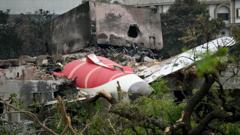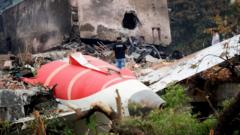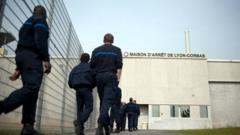The preliminary investigation into Air India Flight 171's crash has uncovered perplexing cockpit recording details and discrepancies regarding fuel control switches. Both investigators and aviation experts highlight potential pilot error while contemplating the implications of the aircraft's safety mechanisms.
Chilling Revelations from Air India Flight 171 Crash Investigation

Chilling Revelations from Air India Flight 171 Crash Investigation
New details on the tragic Air India crash reveal complexities surrounding pilot actions and fuel switches, leaving investigators puzzled.
The preliminary investigation into the tragic Air India Flight 171 crash, which claimed 260 lives in June, has yielded disturbing revelations surrounding cockpit audio and fuel-control switches. Just seconds after takeoff, it appears that the aircraft's fuel-control switches on the Boeing 787 Dreamliner unexpectedly moved to the "cut-off" position, resulting in a catastrophic loss of power to the engines.
The cockpit voice recording captures an unsettling exchange between the pilot and co-pilot, with one questioning why the switches were cut off, only to be met with a denial from the other. This ambiguity surrounding the voice identification leaves investigators puzzled about accountability for the actions taken just moments into the flight.
Reportedly, the flight reached an altitude of 625 feet before losing all data—this critical gap in operational history highlights a variety of concerns as investigators reconstruct events leading up to the crash. The 15-page report suggests that the configuration of the fuel switches should make accidental activation nearly impossible. Designed with a longstanding safety feature, they require deliberate movement to unlock and operate, raising serious questions about the circumstances surrounding their inadvertent switch.
Experts have theorized that if one pilot intentionally or mistakenly cut the fuel, the rationale remains elusive. In any cockpit emergency situation, missteps can occur; nevertheless, there were no indicators of anything abnormal at the time of takeoff. Former investigators have expressed concerns regarding the implications of the cockpit voice recording, underscoring the necessity for more information to decipher the communication around the tragic incident.
The calls for the implementation of cockpit video recorders have resurfaced as a potential solution for preventing such ambiguities in the future, according to aviation safety advocates. Meanwhile, safety assessments regarding the potential malfunction of the fuel switches are ongoing. Notably, while a bulletin from the US FAA underscored similar concerns about fuel control switches on other Boeing models, it did not mandate inspections for Dreamliner variants, which might have contributed to the oversight.
As investigators sift through evidence, including fuel samples deemed satisfactory, the focus has shifted to the possibility of electronic failure linked to the aircraft’s control system—an area still under scrutiny. Furthermore, the activation of the Ram Air Turbine (RAT) was a crucial indicator of a major systems failure, further complicating the tragic nature of the event.
Aviation experts indicate that the series of mismanaged events led to the fuel shut-off, which likely influenced the crew's recovery attempts mid-flight. The urgency of the situation may have left the pilots overwhelmed, unable to adequately react to the dual engine failure in the limited time available.
The investigation continues as the aviation community seeks answers that might clarify the lose behind this devastating crash.





















